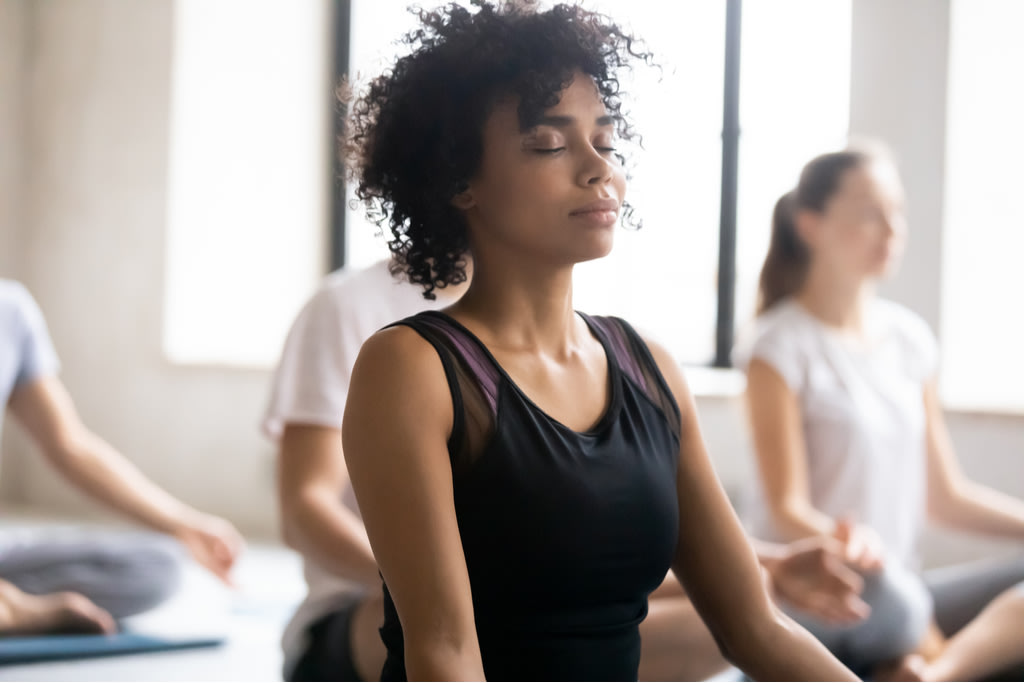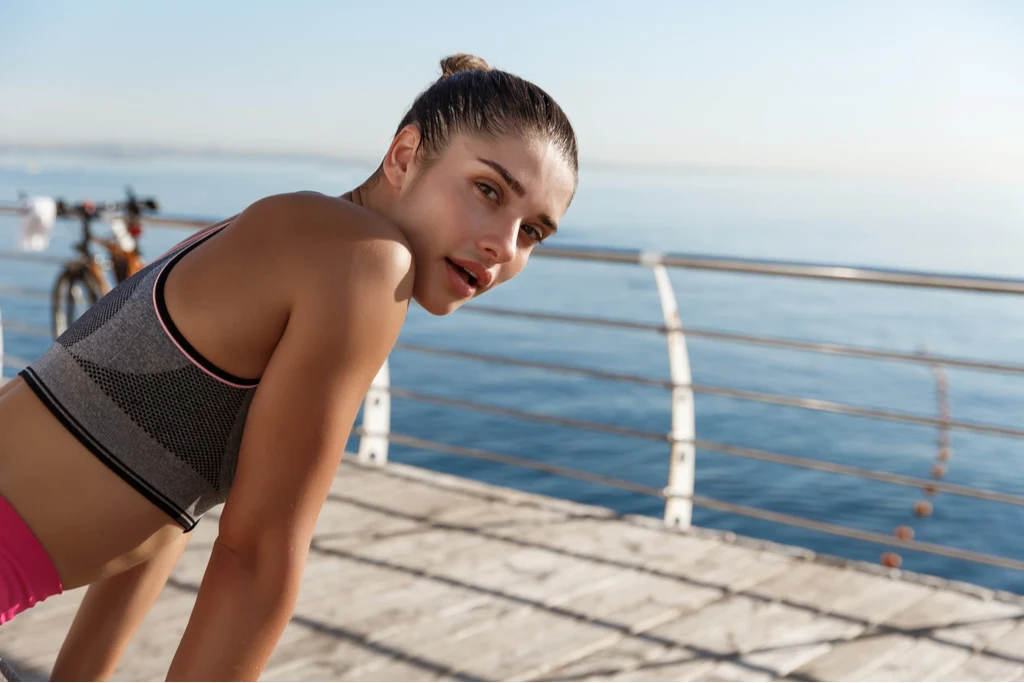Is There A Right Way To Breathe While Exercising?

November 9, 2020

Whether you want to make your workouts more mindful or focus on maximising your performance, learning how to control your breath can help improve your workouts.
Breathing is something you do all day, every day, but learning how to regulate your breathing while you’re exercising can help make your workouts easier and more enjoyable. The correct breathing techniques can even help you make progress by boosting core engagement at the right points in each exercise and encouraging you to maintain correct form throughout each movement.
Why does the way you breathe during exercise matter?
How you breathe — both during exercise and while resting — can impact your blood pressure, heart rate and overall stress levels.
According to the National Heart, Lung and Blood Institute, breathing usually doesn’t require much thought as it’s controlled by your autonomic nervous system. The parasympathetic system (your rest and digest mode) slows the rate of your breath while the sympathetic system (your fight or flight mode) increases it, but your breathing patterns can also change depending on how active you are and the condition of the air around you.
When you exercise, the activity of your heart and lungs are naturally taken up a notch (or several!). Your heart rate increases, as does the depth and frequency of your breathing. Science has shown us your lungs work harder during exercise than when you’re in a resting state, as they are working to increase the amount of oxygen in your blood and expel carbon dioxide, while your heart pumps oxygenated blood to your muscles.
A study that explored the relationship between lungs and exercise highlighted that when your lungs are healthy, you have a larger breathing reserve. This is why you might feel “out of breath” but not “short of breath”. Meanwhile, those with reduced lung function use more of their breathing reserve. Remember, if you have a lung condition, you should discuss your approach to physical activity with your healthcare provider.
When it comes to regulating your breath during exercise, your body will mostly do the work for you, but controlling your breath in certain ways can help to maximise the oxygen delivered to your muscles, allowing you to work out for longer and reduce fatigue.

Proper technique for breathing during exercise
While there are specific breathing techniques for different training styles, here are some breathing techniques you can use for every type of movement.
Breathe into your belly
Your diaphragm is the large, dome-shaped muscle at the base of your lungs. Your abdominal muscles help to move the diaphragm, giving you more power to empty your lungs. Breathing diaphragmatically, aka belly breathing, helps you use this muscle effectively while breathing and use your lungs at 100% capacity.
Cleveland Clinic highlights how this breathing technique can help reduce your blood pressure and heart rate while also promoting relaxation. Belly breathing can help improve muscle function while you’re exercising, preventing strain.
Don’t hold your breath
Your muscles need oxygen to function properly, so it’s important to breathe properly while you exercise, and timing your breathing with your movement can ensure your muscles are adequately oxygenated for optimal performance. While it can feel natural to hold your breath when you lift heavy weights, the Mayo Clinic cautions against this. Instead, they recommend breathing out as you lift and breathing in as you lower.
According to the University of Delaware, breathing out during the effort phase of a lift can help to decrease the risk of sustaining injuries such as vessel strains or hernias which can be caused by excessive internal pressure.
Establish a rhythm
If you’re trying to improve your breathing, it can be helpful to breathe rhythmically, in time with your movement. This can help you to regulate or slow down your breathing — whether that’s while practising yoga, lifting weights or synchronising your breaths with your footfalls when you run.
Use breathing to judge intensity
When you exercise, it’s perfectly normal for it to feel a little harder to breathe, especially if you are working out at a high intensity.
In fact, you can use your breathing to assess your rate of perceived exertion. Don’t forget to listen to your body and ensure you’re not overexerting yourself. According to Mayo Clinic, this is how your breathing should feel depending on the intensity of your training:
Moderate intensity: your breathing quickens but you're not out of breath.
Vigorous intensity: your breathing is deep and rapid. You will find you can't say more than a few words without pausing to take a breath.
Overexertion: you are short of breath.
If you’re finding it hard to breathe, you may need to slow down and decrease the intensity while your fitness improves. However, if you’re doing high-intensity interval training like a Tabata workout, the whole point is to improve your fitness by pushing to your max and being out of breath, and then having a short recovery window. Sometimes, the discomfort of being out of breath is exactly where you want to be!
Should you breathe through your nose or your mouth?
You can breathe through either. A 2017 study exploring the impact of these two breathing methods on anaerobic power output and metabolic responses found mixed results as to which is better, highlighting that it’s ultimately a matter of personal preference.
During low-intensity steady-state cardio (aka LISS), you may feel comfortable breathing through your nose. When you’re working at a high intensity, breathing through your mouth can maximise airflow and allow for rapid exchange of carbon dioxide for oxygen to fuel powerful muscle contractions. During a Pilates workout, you’ll often breathe in through your nose and out through your mouth.

How to breathe for specific types of exercise
Breathing for yoga may be different from breathing during a long run. Each different workout type has its own optimal breathing technique, so here are a few to consider:
Strength training
When it comes to strength training, exhaling as you are exerting effort (for example lift a dumbbell during a bicep curl, for example, pushing during a push-up or pushing the barbell up in a bench press), and inhaling during the lowering phase is most efficient and considered best practice. This breathing method helps to increase stability of the lumbar (lower) spine and core, providing a stronger position for the lift.
Yoga
During yoga, your breath is a key focus of your practice and can help to create a greater sense of calm and mind-body connection. The intention is to sync each pose or ‘asana’ in your yoga flow with your breath (no breath-holding here either!), but there are multiple ways to practice yogic breathing (also known by the Sanskrit name “Pranayama”). One simple form is box breathing, or “Sama Vritti”, where you inhale for four counts, hold for four counts, and then exhale four counts, and repeat.
A 2018 systematic review observed that slow breathing techniques like this produce autonomic nervous system changes, including increasing heart rate variability, a measure of the time between heartbeats that is linked to recovery after stress. In other words, slowing your breathing can help you to recover faster when you are under stress.
Running
When running, most people will adopt a pattern of breathing that is linked in some way to their cadence — the number of times each foot hits the ground.
Research suggests that there is a common way that runners choose to breathe for maximum comfort while running. A 2013 research article observed that runners typically prefer a 2:1 breathing ratio while running — they inhale for two steps, and exhale for one step. Intentionally breathing with this pace may minimise the load placed on your respiratory muscles while running, increase endurance and reduce fatigue.
Pilates
Pilates uses a specific breathing technique to support the movements and keep your core engaged, where you breathe in through your nose, focusing on breathing into the sides of your ribs, and out through your mouth for a more forceful exhalation, enhancing the engagement of your core muscles.
Try these breathing techniques to get the most out of your workouts
Doing breathing exercises can help to improve your workouts, and it’s also a tool that can help to increase mindfulness and improve your overall wellbeing. You can use breathing exercises in your at-home yoga practice, or as part of your recovery sessions to help you to stay on track during your rest days.
Even if you aren’t exercising regularly, incorporating breathing exercises into your day could be the first step you take towards establishing healthy habits that will last.

A more empowered you starts with Sweat, and our editorial team is here to bring you the latest fitness tips, trainer recommendations, wellbeing news, nutritional advice, nourishing recipes and free workouts.
* Disclaimer: This blog post is not intended to replace the advice of a medical professional. The above information should not be used to diagnose, treat, or prevent any disease or medical condition. Please consult your doctor before making any changes to your diet, sleep methods, daily activity, or fitness routine. Sweat assumes no responsibility for any personal injury or damage sustained by any recommendations, opinions, or advice given in this article.
Fitness